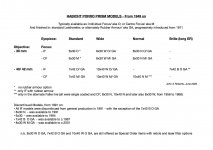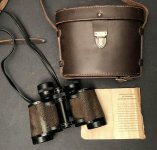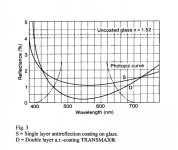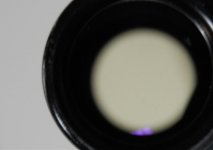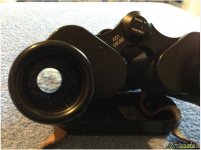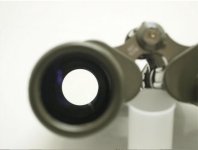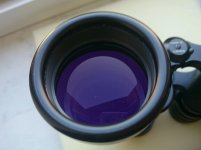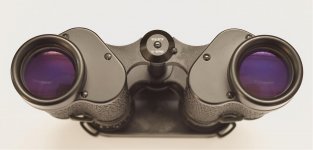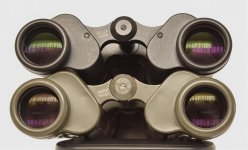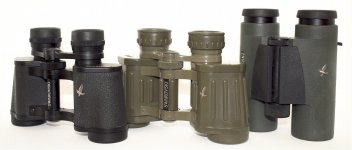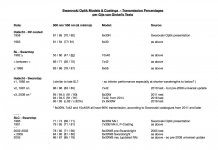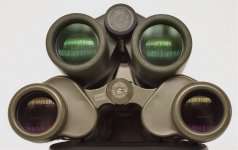John A Roberts
Well-known member

Current production Habicht binoculars offer considerable value for money. They are:
- built to Swarovski’s usual high quality standards
- noted for their on axis resolution, neutral coloured image and bright view (the listed transmission for all models is 96%), and
- waterproof and nitrogen filled, though having a distinctly heavy focuser action
(for a detailed discussion of their attributes and how to maximise their performance, see the thread at: https://www.birdforum.net/showthread.php?t=376504 )
There is a choice of three centre focus models: 8x30W, 7x42 and 10x40W. All are available with a leatherette finish, and the last two are also offered with rubber armour covering
They are considerably cheaper than the other main Swarovski models e.g. while the most expensive Habicht is the rubber armoured 10x40W,
the current SLC 10x42 is around 50% more expensive, and EL FieldPro 10x42 is around twice as expensive
Starting With a Second-Hand Model?
One impediment for those considering a new Habicht is that not many Swarovski dealers keep them in stock, so you may not be able to try before you buy
As such, a second-hand model may be the easiest way to find out if you and a Habicht are a good fit - and depending on the features and price,
it may provide even better value than a new unit
But be warned . . . buying a second-hand unit may lead to further purchases!
The Range Of Choices
Swarovski’s metal bodied Porro prism binoculars have been in continuous production since 1949. In over 70 years around 750,000 have been produced
For more detail, see posts #4 and 5 at: https://www.birdforum.net/showthread.php?t=391080
Due to the time and numbers, there are obvious problems for someone wanting a second-hand model to use - as opposed to what would interest a collector
As a starting point, in terms of the variety of models that have been offered see the attached table
Which To Use?
The Habichts that will be of most interest for use, are those that are both centre focus and are multi-coated aka Swarotop
While Swarotop was introduced on most product lines at the start of the 1980’s, it was not introduced on the Habichts until around 1989
But when this was, in relation to the serial numbering of the various models, is unknown
However, in January 1991 Swarovski adopted Alpha-Numeric serial numbering on all its product lines, and this provides a convenient starting point for someone wanting a unit to use
- as every Alpha-Numeric numbered Habicht is multi-coated
Since 1991 around 115,000 Habichts have been produced, and all but a little over 5,000 are centre focus. So there are plenty of possibilities for those interested
Identifying Swarotop Versions
I’ve been able to identify three main versions of Swarotop on the Habichts, and while the images provided by them differ in degree as to colour and brightness,
any would be acceptable to most current users
• Version 1
For our purposes, from the start of 1991 - from #A61 xxxxx on
It has a slightly yellow image (greatly different to the very strongly yellow one of the previous dual layer coated models)
• Version 2
From early 1997 - by #A6706 36307 at the latest
It has a very slightly yellow image, similar to that of many current binoculars
• Version 3
From the start of 2009 - and verified as by #A7908 87433
It has the neutral ‘paper white’ image now associated with Swarovski’s optics
cont.
- built to Swarovski’s usual high quality standards
- noted for their on axis resolution, neutral coloured image and bright view (the listed transmission for all models is 96%), and
- waterproof and nitrogen filled, though having a distinctly heavy focuser action
(for a detailed discussion of their attributes and how to maximise their performance, see the thread at: https://www.birdforum.net/showthread.php?t=376504 )
There is a choice of three centre focus models: 8x30W, 7x42 and 10x40W. All are available with a leatherette finish, and the last two are also offered with rubber armour covering
They are considerably cheaper than the other main Swarovski models e.g. while the most expensive Habicht is the rubber armoured 10x40W,
the current SLC 10x42 is around 50% more expensive, and EL FieldPro 10x42 is around twice as expensive
Starting With a Second-Hand Model?
One impediment for those considering a new Habicht is that not many Swarovski dealers keep them in stock, so you may not be able to try before you buy
As such, a second-hand model may be the easiest way to find out if you and a Habicht are a good fit - and depending on the features and price,
it may provide even better value than a new unit
But be warned . . . buying a second-hand unit may lead to further purchases!
The Range Of Choices
Swarovski’s metal bodied Porro prism binoculars have been in continuous production since 1949. In over 70 years around 750,000 have been produced
For more detail, see posts #4 and 5 at: https://www.birdforum.net/showthread.php?t=391080
Due to the time and numbers, there are obvious problems for someone wanting a second-hand model to use - as opposed to what would interest a collector
As a starting point, in terms of the variety of models that have been offered see the attached table
Which To Use?
The Habichts that will be of most interest for use, are those that are both centre focus and are multi-coated aka Swarotop
While Swarotop was introduced on most product lines at the start of the 1980’s, it was not introduced on the Habichts until around 1989
But when this was, in relation to the serial numbering of the various models, is unknown
However, in January 1991 Swarovski adopted Alpha-Numeric serial numbering on all its product lines, and this provides a convenient starting point for someone wanting a unit to use
- as every Alpha-Numeric numbered Habicht is multi-coated
Since 1991 around 115,000 Habichts have been produced, and all but a little over 5,000 are centre focus. So there are plenty of possibilities for those interested
Identifying Swarotop Versions
I’ve been able to identify three main versions of Swarotop on the Habichts, and while the images provided by them differ in degree as to colour and brightness,
any would be acceptable to most current users
• Version 1
For our purposes, from the start of 1991 - from #A61 xxxxx on
It has a slightly yellow image (greatly different to the very strongly yellow one of the previous dual layer coated models)
• Version 2
From early 1997 - by #A6706 36307 at the latest
It has a very slightly yellow image, similar to that of many current binoculars
• Version 3
From the start of 2009 - and verified as by #A7908 87433
It has the neutral ‘paper white’ image now associated with Swarovski’s optics
cont.




